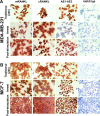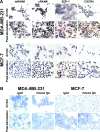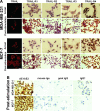Expression of osteoprotegerin, receptor activator of nuclear factor kappa-B ligand, tumor necrosis factor-related apoptosis-inducing ligand, stromal cell-derived factor-1 and their receptors in epithelial metastatic breast cancer cell lines
- PMID: 22709548
- PMCID: PMC3478192
- DOI: 10.1186/1475-2867-12-29
Expression of osteoprotegerin, receptor activator of nuclear factor kappa-B ligand, tumor necrosis factor-related apoptosis-inducing ligand, stromal cell-derived factor-1 and their receptors in epithelial metastatic breast cancer cell lines
Abstract
Background: While breast cancer (BC) is the major cause of death among women worldwide, there is no guarantee of better patient survival because many of these patients develop primarily metastases, despite efforts to detect it in its early stages. Bone metastasis is a common complication that occurs in 65-80 % of patients with disseminated disease, but the molecular basis underlying dormancy, dissemination and establishment of metastasis is not understood. Our objective has been to evaluate simultaneously osteoprotegerin (OPG), receptor activator of nuclear factor kappa B ligand (RANKL), tumor necrosis factor-related apoptosis-inducing ligand (TRAIL), stromal cell-derived factor-1 (SDF-1), and their receptors (R) in 2 human BC cell lines, MDA-MB-231 and MCF-7.
Methods: OPG, RANKL, TRAIL and SDF-1 expression and release, in addition to the expression of their receptors has been investigated using immunofluorescence, immunocytochemistry and ELISA analyses.
Results: MCF-7 cells released higher levels of OPG in conditioned media (CM) than MDA-MB-231 cells; 100 % of both types of cell expressed OPG, RANKL, TRAIL and SDF-1. Moreover, 100 % in both lines expressed membrane RANKL and RANK, whereas only 50 % expressed CXCR4. Furthermore, 100 % expressed TRAIL-R1 and R4, 30-50 % TRAIL-R2, and 40-55 % TRAIL-R3.
Conclusions: MCF-7 and MDA-MB-231 cells not only released OPG, but expressed RANKL, TRAIL and SDF-1. The majority of the cells also expressed RANK, CXCR4 and TRAIL-R. Since these ligands and their receptors are implicated in the regulation of proliferation, survival, migration and future bone metastasis during breast tumor progression, assessment of these molecules in tumor biopsies of BC patients could be useful in identifying patients with more aggressive tumors that are also at risk of bone metastasis, which may thus improve the available options for therapeutic intervention.
Figures






References
-
- Bhatia P, Sanders MM, Hansen MF. Expression of receptor activator of nuclear factor-kappaB is inversely correlated with metastatic phenotype in breast carcinoma. Clin Cancer Res. 2005;11:162–165. - PubMed
LinkOut - more resources
Full Text Sources
Miscellaneous

